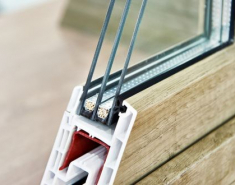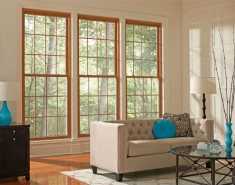Making Sense of a Window Label
If you’ve shopped for replacement windows, you’ve probably seen the National Fenestration Rating Council (NFRC) window label, complete with numbers and ratings for various specs related to energy efficiency and performance. Sometimes you’ll see an Energy Star logo alongside it, too.
The certification from the NFRC is created with data from third-party labs that test windows for certain attributes, such as visible transmittance, solar heat gain coefficient, and more. Past tests by CR found NFRC ratings to be accurate and reliable, so we devised our current test procedure (see our ratings and buying guide for replacement windows) to be complementary.
That doesn’t mean that the labels’ ratings and jargon are easy to parse, though. Here, we break down the meaning of each figure on the NFRC’s sticker. Hover over each rating for a description.
Glass Type and Product Information
You’ll find a frame type, along with any coatings on the glass (this window has a low-E, or low-emissivity, coating) and the gas that fills the cavity between glass panes (in this case, argon), contributing to the product’s overall energy efficiency.
Solar Heat Gain Coefficient
This number measures how well a product can keep solar heat from penetrating the window. The range is 0 to 1. If you live in a hot, sunny climate, such as Arizona’s, you will want a low number to block out heat; if you live in a colder climate, you’ll want a high number. If you live in a balanced climate, where winters are cold and summers are hot, you’ll want a solar heat gain coefficient rating of around 0.3 (same goes for U-factor). And you may want windows with different ratings for different parts of your house, depending on whether particular windows get a lot of sun or shade.
Air Leakage
This is how much outside air will come through, according to the NFRC’s testing. The lower the number, the better. (The range here is less than or equal to 0.1 to 0.3.) “In our tests, we take this a step further by testing at very low temperatures with high wind conditions to see if there are any changes in performance due to materials expanding and contracting,” says CR’s Enrique de Paz.
Condensation Resistance
Not every label will carry this optional rating. But for those who live in a humid climate and/or are concerned with mold growth, you may want to look at the condensation resistance rating, which is on a scale from 1 to 100. The higher the number, the better the window is at resisting condensation.
Visible Transmittance
This is how much visible light will come in through the window during daytime. The range is 0 to 1, and the higher the number, the more visible light passes through. Clear glass without any coatings has the highest VT rating. But coatings that you may add to improve energy efficiency can sacrifice some visible light.
U-Factor
This number represents the heat transfer coefficient, or how much heat the window’s coatings help keep inside the home. U-factor ranges from 0.2 to 1.2; the lower the number, the less heat escapes.
Source: https://bit.ly/34rxEVd









